







| Sgt. William A. Horton - United States Army Air Corps |
| Sgt. William A. Horton - A small grouping of items related to Sgt. Horton and his military career during WWII. This display does not provide a detailed history of Sgt. Horton's military career, but provides a look at the various types of paperwork carried and encountered by Army Air Corps personnel during the war years. This is a small portion of the items in the grouping related to Sgt. Horton. Above: a wartime 8x10 and good conduct pass related to Sgt. Horton. |
| A wartime photograph of an Army Air Corps dance at Del Valle Army Air Field. |
| Several paperwork items related to Sgt. Horton's career, including several good conduct and day passes and Sgt. Horton's Physical Record Card. Other items from this grouping not shown include Sgt. Horton's immunization records, additional teletypes, award certificates. |

| Sgt. Horton's Venereal Disease Control card from Malden Army Air Field, showing that Sgt. Horton had attended all the required lectures regarding venereal disease. |

| James E. Sinderson - United States Army Air Corps |


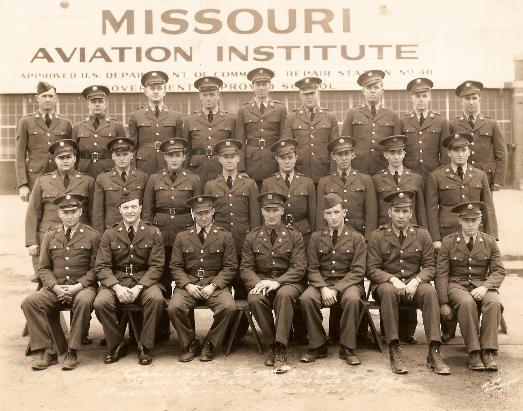




| James E. Sinderson - United States Army Air Corps James Sinderson bravely served in the United States Army Air Corps, graduating from the Missouri Aviation Institute as an aircraft mechanic on January 26th, 1942. On July 27, 1942, Sinderson graduated from an Air Corps Training Center as an aerial gunner. At the time, Sinderson was assigned to the 406th Bomb Squadron, 42nd Bomb Group. Following the war, Sinderson served a long and successful career with TWA. His career as a flight engineer with TWA started on April 9, 1946, ending with his retirement on January 1, 1984. Shown are a few items from Sinderson's military career including two hand colored, wartime photographs of Sinderson, a group photograph from the Missouri Aviation Institute, two Air Corps diplomas and a retirement certificate from TWA, commemorating Sinderson's career in commercial aviation. In the group photograph, Sinderson is standing in the second row, fourth from the right. |
| Richard N. Lewis - United States Army Air Corps |




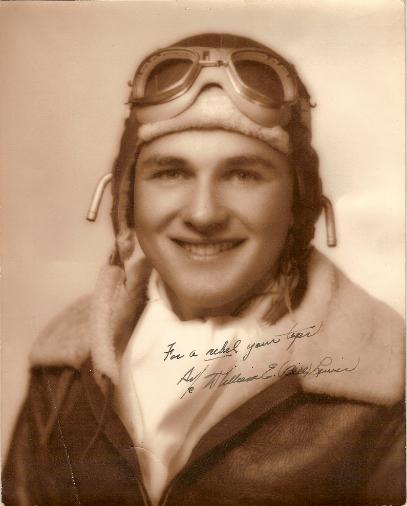

| Richard Norman Lewis - United States Army Air Corps A small grouping related to Army Air Corps cadet/pilot Richard N. Lewis, of Norfolk, Virginia. The photographs below were acquired along with Lewis' training yearbook from the 303rd AAFFTD (Army Air Force Flying Training Detachment) stationed at Cuero, Texas, with training conducted by the Brayton Flying Service. Lewis' yearbook is filled with 47 signatures of flying cadets and instructors from Lewis' class. The yearbook also contains a certificate indicating Lewis completed his first solo flight on April 3, 1944, signed by flight instructor Calvin C. Conly of the Brayton Flying Service. |
| Cadet Richard N. Lewis in the front seat of a PT-19 trainer. |
| A group photograph of Army Air Corps cadets of Lewis' class. Lewis is kneeling in the front row, on the far left. Next to Lewis is fellow cadet and friend, William Lewis. There is an unknown joke occurring here as all of the standing cadets have their pants on backwards. |
| Lewis' copy of his 1944 303rd AAFFTD yearbook. The inside cover has an inscription from Lewis, who sent this book home to his father. |
| A photograph described on the reverse of the photo as "The Raunchy Foursome." From left to right: Richard M. "Dick" Field, Bruce W. Fluck, Richard N. "Rebel" Lewis and Edward "Prof" Laski. |
| Two 8x10 photographs of cadets and friends who flew with Lewis. On the left: William E. (Bill) Lewis. On the right: Edwin Randolph "Randy" Lewis. Both of the photographs shown above were taken in 1944. |

| United States Army Air Corps Groupings |
| This page displays smaller groupings related to men who served in the United States Army Air Corps. Despite being smaller groupings, each provides a glimpse into the life of personnel of the wartime Army Air Corps, and shows various wartime paperwork encountered with this branch of service. If anyone has any additional information or material related to these three gentlemen, I would enjoy hearing from you. |

Robert Lomench - United States Army Air Corps



| This section shows a small grouping of items related to 2nd Lt. Robert Lomench, a pilot in the United States Army Air Corps. Above: Two photographs of Lomench. Right: A pilot's information card for Hobbs Army Air Field, Hobbs, New Mexico, dated 2-14-44. |


| Above: (Left) Lomench's Honorable Discharge certificate after having completed training as an Army Air Corps cadet. (Right) Lomench's military discharge paperwork dated September 21, 1945, discharging him from the United States Army Air Corps. |


| Above: One of several Local Flying Clearance forms which came with the Lomench grouping, each one from Kingman Army Air Field, Kingman Arizona. The form shows Lomench made a local flight on 1-8-45, flying a P-39 Aircobra. Additional items in this grouping included numerous Kingman Army Air Field forms, certified copies of Lomench's war record, discharge papers and numerous invitations to his graduation from Advanced Flight School, Class 44-D at Luke Army Air Field. |
| Left: An Aircraft Arrival Report from Kingman Army Air Field, Kingman, Arizona, dated 11-16-44. The report indicates that Lomench and another pilot, 2nd Lt. R.E. Nickerson, completed a flight in P-39 Aircobras, ended their flight at Kingman Army Air Field. During the flight, Lomench flew a P-39 with a serial number of 41-7052, while Nickerson flew a P-39 with a serial number of 41-6931. Both of these aircraft survived the war and were transferred to the Reconstruction Finance Corporation in Ontario, California on May 28, 1945. The Reconstruction Finance Corporation was in part responsible for handling surplus aircraft at the end of the war. Of the approximately 61,600 aircraft that went to the RFC, approximately 34,700 were sold for flying purposes while the remaining 26,900 aircraft were sold for scrap. |
| For additional information related to the 458th Bomb Group, click on the B-24 tail rudder to the left and visit a terrific site dedicated to this courageous group of aviators and airmen. www.458bg.com |







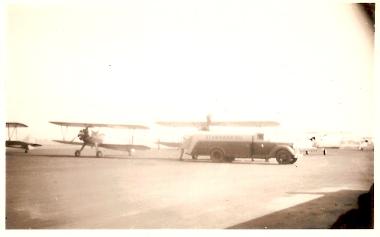



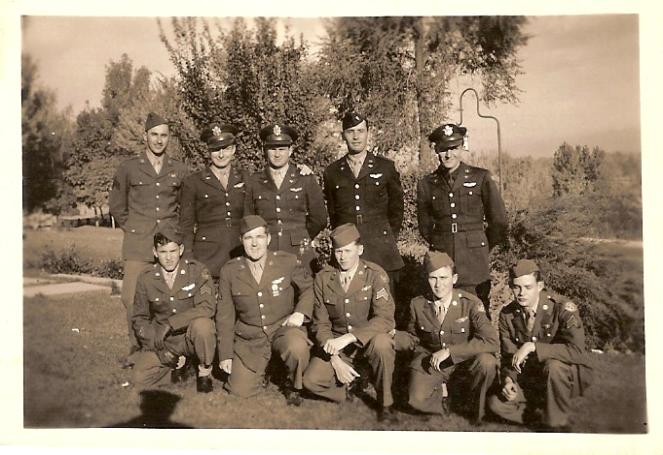





| Crew 17 while Stateside (L-R) Back Row: Rene Neirynck, Edward Eichorn, Lawrence Menz, John Hejl, Verdon Cox Front Row: Fred Smith, Asby Paul, Joseph Myer, Franklin Reavis, Donald Day |
| Back Row: Edward Eichorn - B, Lawrence Menz - P, John Hejl - CP, Joseph Meyer - E. Middle Row: Asby Paul - RO, Donald Day - TG, Rene Neirynck - TTG Front Row: Fred Smith - BTG, Franklin Reavis - BTG |
| Above: A photograph of bombardier Nicholas "Nick" F. Flynn of Boston, Mass. Flynn served as Menz' bombardier when the two men were training together at Tonopah, in crew #410. The reverse of the photograph identifies Mr. Flynn, providing his home address in Boston. The photograph is dated May 17, 1945. |


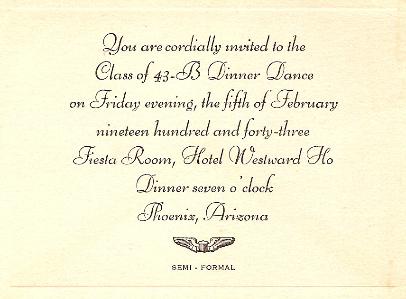

| August 2009. A recent addition to my collection was a large grouping of items related to Army Air Corps pilot, 1st Lt. Lawrence F. Menz. Lawrence Menz was born on May 18, 1921. With his home town listed as Kennett, Missouri, Menz stood 5'8 1/2'' tall and weighed 170 pounds when he entered the service, with brown hair and blue eyes. His civilian work history showed him employed by the Maloney Electric Company in St. Louis, Missouri, with his trade being that of a transformer assembler. His salary while working for the Maloney Electric Company was $125.00 a month. This page was put together to display some of the many items from the Menz grouping, which now resides in my permanent collection. The page is dedicated to 1st Lt. Menz and the men he served with, specifically those of the 458th Bomb Group and more specifically, "Crew 17." Please feel free to contact me with any comments, corrections or questions. |
| Paperwork, Paperwork and more Paperwork! |
| Lt. Menz grouping included a stack of paperwork containing over 300 pages of wartime documents relating to his overall military service during WWII including: training documents, orders, his last will and testament, medical records, flight logs, promotion records and identification and qualification cards. Below is a very small example of some of the paperwork items found in Lt. Menz' grouping. The paperwork covers a time period from 1942 to late 1945. The paperwork shown below provides a terrific glimpse into the life of an Army Air Corps pilot and the paperwork items they encountered during their career. |
| Lawrence Menz and the 458th Bomb Group - stateside training prior to overseas deployment. |

| Above: An Army Air Corps sweater with a leather name tag showing the name of L.F. Menz, acts as the background for Menz' Army Air Corps identification wallet which contained his Army Air Corps identification card and his Pilot and Crew Member Physical Record Card. |
| Of interest among the paperwork items shown above is the Air Corps Reserve document on the lower right corner, which bears the signature of Colonel John C. Horton, who ultimately retired as a Brigadier General. |
| Preflight School: Santa Ana Army Air Base Completed: August/1942 Primary Flight Training: Rankin Academy, Tulare, California Completed: October/1942 Basic Flying School: Merced AFS Completed: December/1942 Advanced Flight Training: Luke Field, Arizona Completed: February/1943 Army Air Force School of Applied Tactics: Orlando, Florida Completed: May/1943 Transition Flight Training: Roswell Army Air Field Completed: August/1943 |
| Throughout his training and military career, Menz flew a variety of aircraft. Some of the aircraft types flown by Menz include: B-32 Dominator, B-24 Liberators (various models), B-25 Mitchell (various models), B-17 Fortress (various models), AT-6 Texan, BT-13 Valiant, AT-9 Fledgling, and the A-20 Havoc. The vast majority of Menz' flight time was spent in various models of the B-25 and the B-24. |
| Menz spent his time at Tonopah training with "Crew 17", in preparation for overseas deployment. A fantastic website dedicated to the 458th Bomb Group (www.458bg.com) has the following information related to Menz: "According to gunner Rene Neirynck, "The last part of our training at Tonopah was for the gunners to shoot at a sleeve target. During our turn to shoot, the tow plane broke down so we missed the training. Lt. Menz refused to go into combat without that training and was taken off Crew 17." Menz was eventually replaced by 1st Lt Millard P. Schaaf who took over as the lead pilot for the Menz crew, eventually leading the crew into combat operations. To learn more about "Crew 17" and the 458th Bomb Group, click on the following link: www.458bg.com/crew17schaaf.htm. On December 29, 1943, Menz was assigned to the 470th Bomb Group (H) at Mt. Home, Idaho. No specific reason was given for the transfer from the 458th Bomb Group to the 470th Bomb Group. From all of the included paperwork, it appears Menz never entered into combat, and instead remained stationed in the United States, acting as a ferry pilot for various types of aircraft until the end of the war. |
| A special thank you to Darin Scorza for his help and assistance in putting this page together. If anyone has any additional information concerning 1st Lt. Menz, please feel free to contact me at: webmaster@danielsww2.com. |
| Menz was ordered to report to the Army Air Corps Cadet Training Detachment at Sikeston, Missouri on April 17, 1942. His apparent desire, like that of many young men during the war, to become an Army Air Corps pilot. On May 24, 1942, Menz was assigned to aviation cadet training as a private. His Army Air Corps Air Crew Data card provides us with a good overview of his military career and training: |

Lawrence F. Menz - 458th Bomb Group (H)
| The C.E. Daniel Collection |

